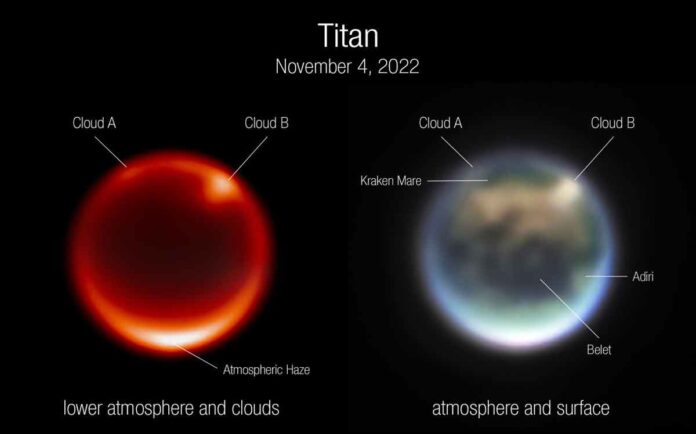The James Webb Space Telescope (JWST) has directed its infrared cameras toward Saturn’s moon Titan. It provided astronomers with a new perspective on the largest and most unusual moon in the solar system.
It’s the only satellite with a dense atmosphere. It’s also the only world besides Earth with standing bodies of liquid on its surface, such as rivers. Though the liquid is thought to be methane, ethane, and other toxic hydrocarbons.
The new observations will aid astronomers in understanding Titan’s weather patterns. It will be beneficial ahead of the launch of NASA’s Dragonfly mission to the moon in 2027. Dragonfly, a multirotor lander, will assess Titan’s habitability. It will investigate the moon’s unusual chemical stew, and look for signs of water-based or hydrocarbon-based life.
Titan has been studied by astronomers for decades. It was long before the Voyager encounter in 1980. They focused powerful ground-based and orbital telescopes on the satellite over the last 25 years. It was supplementing observations by NASA’s Cassini mission to Saturn, which observed Titan between 2004 and 2017. Imke de Pater of the University of California, Berkeley, led many Titan observations. Imke has used high-resolution adaptive optics on the Keck Telescopes in Hawaii.
The JWST imaged Titan on November 4. The Titan team noticed what appeared to be two clouds in the atmosphere. Conor Nixon, Titan team lead, quickly emailed de Pater and Katherine de Kleer, a UC Berkeley Ph.D. Nixon wanted to confirm the clouds and track their movement with the Keck Telescope.
A series of Keck images taken between 30 and 54 hours later. It revealed clouds that were similar but slightly displaced due to the moon’s rotation relative to Earth.
The JWST and Keck images appear to be of comparable quality to the untrained eye. de Pater noted that JWST has instruments that can measure aspects of Titan’s atmosphere that Keck cannot. Thus, it complemented one another. JWST’s infrared spectroscopic capability, allows it to pinpoint the altitudes of clouds and hazes with much greater accuracy.
JWST can observe and provide information on the lower atmosphere and surface at wavelengths where the Earth’s atmosphere is opaque. Titan cannot be seen from any Earth-based telescope.
De Pater and de Kleer took part in an international observing campaign to catch Titan’s occultation of a distant star in early September. The occultation, organised by Eliot Young, a senior programme manager at the Southwest Research Institute in Boulder, Colorado, provided an opportunity to investigate Titan’s atmospheric structure in greater depth using the Keck Telescope and the Very Large Telescope in Chile.
These observations are coordinated with other large telescope occultations and Doppler wind retrievals on Titan from the Atacama Large Millimeter Array, a radio telescope in Chile.
These observations, combined with recent wind modelling results, contribute to a better understanding of atmospheres on Earth, planets around other stars, and our solar system’s neighbouring planets and moons.

